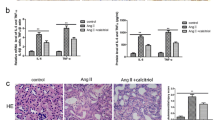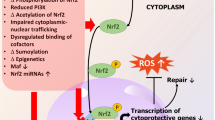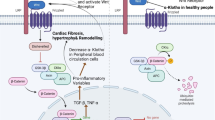Abstract
Angiotensin II (Ang II), a major effector of the renin–angiotensin system, is now recognized as a pro-inflammatory mediator. This Ang II signaling, which causes transcription of pro-inflammatory genes, is regulated through nuclear factor-κB (NF-κB). At present, the molecular mechanisms underlying the effect of aging on Ang II signaling and NF-κB activation are not fully understood. The purpose of this study was to document altered molecular events involved in age-related changes in Ang II signaling and NF-κB activation. Experimentations were carried out using kidney tissues from Fischer 344 rats at 6, 12, 18, and 24 months of age, and the rat endothelial cell line, YPEN-1 for the detailed molecular work. Results show that increases in Ang II and Ang II type 1 receptor during aging were accompanied by the generation of reactive species. Increased Ang II activated NF-κB by phosphorylating IκBα and p65. Increased phosphorylation of p65 at Ser 536 was mediated by the enhanced phosphorylation of IκB kinase αβ, while phosphorylation site Ser 276 of p65 was mediated by upregulated mitogen-activated and stress-activated protein kinase-1. These altered molecular events in aged animals were partly verified by experiments using YPEN-1 cells. Collectively, our findings provide molecular insights into the pro-inflammatory actions of Ang II, actions that influence the phosphorylation of p65-mediated NF-κB activation during aging. Our study demonstrates the age-related pleiotropic nature of the physiologically important Ang II can change into a deleterious culprit that contributes to an increased incidence of many chronic diseases such as atherosclerosis, diabetes, and dementia.





Similar content being viewed by others
References
Alvarez A, Cerda-Nicolas M, Naim Abu Nabah Y, Mata M, Issekutz A, Panes J, Lobb R, Sanz M (2004) Direct evidence of leukocyte adhesion in arterioles by angiotensin II. Blood 104:402–408
Atkinson A, Brown J, Fraser R, Lever A, Morton J, Riegger A, Robertson J (1980) Angiotensin II and renal hypertension in dog, rat and man: effect of converting enzyme inhibition. Clin Exp Hypertens 2:499–524
Basseres D, Baldwin A (2006) Nuclear factor-kappaB and inhibitor of kappaB kinase pathways in oncogenic initiation and progression. Oncogene 25:6817–6830
Basso N, Paglia N, Stella I, de Cavanagh E, Ferder L, del Rosario Lores Arnaiz M, Inserra F (2005) Protective effect of the inhibition of the renin–angiotensin system on aging. Regul Pept 128:247–252
Bertrand V, Guessous F, Le Roy AL, Viossat B, Fessi H, El Abbouyi A, Giroud JP, Roch-Arveiller M (1999) Copper-indomethacinate associated with zwitterionic phospholipids prevents enteropathy in rats: effect on inducible NO synthase. Dig Dis Sci 44(5):991–999
Carey R, Siragy H (2003) Newly recognized components of the renin-angiotensin system: potential roles in cardiovascular and renal regulation. Endocr Rev 24:261–271
Cassis P, Conti S, Remuzzi G, Benigni A (2010) Angiotensin receptors as determinants of life span. Pflugers Arch 459:325–332
Chai W, Danser A (2005) Is angiotensin II made inside or outside of the cell? Curr Hypertens Rep 2:124–127
Chen L, Greene W (2004) Shaping the nuclear action of NF-κB. Nat Rev Mol Cell Biol 5:392–401
Chung H, Kim H, Kim J, Yu B (2006) The inflammation hypothesis of aging. Ann NY Acad Sci 928:327–335
Chung HY, Cesari M, Anton S, Marzetti E, Giovannini S, Seo AY, Carter C, Yu BP, Leeuwenburgh C (2009) Molecular inflammation: underpinnings of aging and age-related diseases. Ageing Res Rev 1:18–30
Cui R, Tieu B, Recinos A, Tilton R, Brasier A (2006) RhoA mediates angiotensin II-induced phospho-Ser536 nuclear factor kappa B/RelA subunit exchange on the interleukin-6 promoter in VSMCs. Circ Res 99:723
de Cavanagh E, Piotrkowski B, Basso N, Stella I, Inserra F, Ferder L, Fraga C (2003) Enalapril and losartan attenuate mitochondrial dysfunction in aged rats. FASEB J 9:1096–1098
de Cavanagh E, Piotrkowski B, Fraga C (2004) Concerted action of the renin–angiotensin system, mitochondria, and antioxidant defenses in aging. Mol Aspects Med 25:27–36
Diz D, Lewis K (2008) Dahl memorial lecture: the renin–angiotensin system and aging. Hypertension 52:37–43
Douillette A, Bibeau-Poirier A, Gravel S, Clement J, Chenard V, Moreau P, Servant M (2006) The proinflammatory actions of angiotensin II are dependent on p65 phosphorylation by the IκB kinase complex. J Biol Chem 19:13275–13284
Endemann D, Schiffrin E (2004) Endothelial dysfunction. J Am Soc Nephrol 15(8):1983–1992
Ferder L, Inserra F, Martinez-Maldonado M (2006) Inflammation and the metabolic syndrome: role of angiotensin II and oxidative stress. Curr Hypertens Rep 8:191–198
Ferrario C, Strawn W (2006) Role of the renin–angiotensin–aldosterone system and proinflammatory mediators in cardiovascular disease. Am J Cardiol 98:121–128
Garrido A, Griendling K (2009) NADPH oxidases and angiotensin II receptor signaling. Mol Cell Endocrinol 302:148–158
Gilmore T (2006) Introduction to NF-κB: players, pathways, perspectives. Oncogene 25:6680–6684
Higashi Y, Chayama K, Yoshizumi M (2005) Angiotensin II type I receptor blocker and endothelial function in humans: role of nitric oxide and oxidative stress. Curr Med Chem Cardiovasc Hematol Agents 3:133–148
Hitomi H, Kiyomoto H, Nishiyama A (2007) Angiotensin II and oxidative stress. Curr Opin Cardiol 4:311–315
Hoffmann A, Levchenko A, Scott M, Baltimore D (2002) The IκB-NF-κB signaling module: temporal control and selective gene activation. Science 298:1241–1245
Jaimes E, Tian R, Pearse D, Raij L (2005) Up-regulation of glomerular COX-2 by angiotensin II: role of reactive oxygen species. Kidney Int 5:2143–2153
Jaimes E, Hua P, Tian R, Raij L (2010) Human glomerular endothelium: interplay among glucose, free fatty acids, angiotensin II, and oxidative stress. Am J Physiol Renal Physiol 298:F125–F132
Khan N, Hemmelgarn B, Herman R, Rabkin S, McAlister F, Bell C, Touyz R, Padwal R, Leiter L, Mahon J, Hill M, Larochelle P, Feldman R, Schiffrin E, Campbell N, Arnold M, Moe G, Campbell T, Milot A, Stone J, Jones C, Ogilvie R, Hamet P, Fodor G, Carruthers G, Burns K, Ruzicka M, dechamplain J, Pylypchuk G, Petrella R, Boulanger J, Trudeau L, Hegele R, Woo V, McFarlane P, Vallée M, Howlett J, Katzmarzyk P, Tobe S, Lewanczuk R (2008) The 2008 Canadian Hypertension Education Program recommendations for the management of hypertension: part 2—therapy. Can J Cardiol 6:465–475
Kim J, Jung J, Yu P, Cho G, Choi S, Chung Y (2002a) Modulation of redox-sensitive transcription factors by calorie restriction during aging. Mech Ageing Dev 12:1589–1595
Kim J, Lee E, Park G, Kim M, Yokozawa T, Yu B, Chung H (2002b) Morin modulates the oxidative stress-induced NF-kappaB pathway through its anti-oxidant activity. Free Radic Res 4:454–461
Kim M, Lee K, Kim H, Yu P, Chung H (2010a) Kaempferol modulates pro-inflammatory NF-kappaB activation by suppressing advanced glycation endproducts-induced NADPH oxidase. Age 2:197–208
Kim M, Chung S, Kim D, Kim J, Lee E, Kim J, Ha Y, Kim Y, No J, Chung H, Park K, Rhee S, Choi J, Yu B, Yokozawa T, Kim Y, Chung H (2010b) Modulation of age-related NF-kappaB activation by dietary zingerone via MAPK pathway. Exp Gerontol 6:419–426
Kobori H, Nangaku M, Navar LG, Nishiyama A (2007) The intrarenal renin–angiotensin system: from physiology to the pathobiology of hypertension and kidney disease. Pharmacol Rev 3:251–287
Laemmli U (1970) Cleavage of structural proteins during the assembly of the head of bacteriophage T4. Nature 227:680–685
Lassegue B, Sorescu D, Szocs K, Yin Q, Akers M, Zhang Y, Grant S, Lambeth J, Griendling K (2001) Novel gp91phox homologues in vascular smooth muscle cells: nox1 mediates angiotensin II-induced superoxide formation and redox-sensitive signaling pathways. Circ Res 9:888–894
Lee E, Chung S, Kim J, Kim J, Heo H, Lim H, Kim M, Anton S, Yokozawa T, Chung H (2009) Allylmethylsulfide down-regulates X-ray irradiation-induced nuclear factor-kappaB signaling in C57/BL6 mouse kidney. J Med Food 3:542–551
Luo J, Kamata H, Karin M (2005) IKK/NF-κB signaling: balancing life and death—a new approach to cancer therapy. J Clin Invest 10:2625–2632
Manjunath G, Tighiouart H, Coresh J, Macleod B, Salem D, Griffith J, Levey A, Sarnak M (2003) Level of kidney function as a risk factor for cardiovascular outcomes in the elderly. Kidney Int 63:1121–1129
Mehta P, Griendling K (2007) Angiotensin II cell signaling: physiological and pathological effects in the cardiovascular system. Am J Physiol Cell Physiol 1:C82–C97
Modrick M, Didion SP, Sigmund C, Faraci F (2009) Role of hydrogen peroxide and the impact of glutathione peroxidase-1 in regulation of cerebral vascular tone. Am J Physiol Heart Circ Physiol 6:H1914–H1919
Muller D, Dechend R, Mervaala E, Park J, Schmidt F, Fiebeler A, Theuer J, Breu V, Ganten D, Haller H (2000) NF-{kappa} B inhibition ameliorates angiotensin II-induced inflammatory damage in rats. Hypertension 35:193–201
Ruiz-Ortega M, Lorenzo O, Ruperez M, Konig S, Wittig B, Egido J (2000) Angiotensin II activates nuclear transcription factor kappaB through AT (1) and AT (2) in vascular smooth muscle cells: molecular mechanisms. Circ Res 12:1266–1272
Ruiz-Ortega M, Ruperez M, Esteban V, Rodriguez-Vita J, Sanchez-Lopez E, Carvajal G, Egido J (2006) Angiotensin II: a key factor in the inflammatory and fibrotic response in kidney diseases. Nephrol Dial Transplant 1:16–20
Schulman I, Zhou M, Treuer A, Chadipiralla K, Hare J, Raij L (2010) Altered renal expression of angiotensin II receptors, renin receptor, and ACE-2 precede the development of renal fibrosis in aging rats. Am J Nephrol 3:249–261
Seals D, DeSouza C, Donato A, Tanaka H (2008) Habitual exercise and arterial aging. J Appl Physiol 4:1323–1332
Seshiah P, Weber D, Rocic P, Valppu L, Taniyama Y, Griendling K (2002) Angiotensin II stimulation of NAD(P)H oxidase activity: upstream mediators. Circ Res 5:406–413
Stumpf C, John S, Jukic J, Yilmaz A, Raaz D, Schmieder R, Daniel W, Garlichs C (2005) Enhanced levels of platelet P-selectin and circulating cytokines in young patients with mild arterial hypertension. J Hypertens 5:995–1000
Swanson G, Hanesworth J, Sardinia M, Coleman J, Wright J, Hall K, Miller-Wing A, Stobb J, Cook V, Harding E (1992) Discovery of a distinct binding site for angiotensin II (3-8), a putative angiotensin IV receptor. Regulatorypeptides 40:409–419
Touyz R, Yao G, Schiffrin E (2003) c-Src induces phosphorylation and translocation of p47phox: role in superoxide generation by angiotensin II in human vascular smooth muscle cells. Arterioscler Thromb Vasc Biol 6:981–987
Umezawa K, Ariga A, Matsumoto N (2000) Naturally occurring and synthetic inhibitors of NF-kappaB functions. Anticancer Drug Des 4:239–244
Ungvari Z, Wolin M, Csiszar A (2006) Mechanosensitive production of reactive oxygen species in endothelial and smooth muscle cells: role in microvascular remodeling? Antioxid Redox Signal 8:1121–1129
Viatour P, Merville M, Bours V, Chariot A (2005) Phosphorylation of NF-[kappa] B and I [kappa] B proteins: implications in cancer and inflammation. Trends Biochem Sci 1:43–52
Wei Y, Sowers J, Clark S, Li W, Ferrario C, Stump C (2008) Angiotensin II-induced skeletal muscle insulin resistance mediated by NF-kappaB activation via NADPH oxidase. Am J Physiol Endocrinol Metab 2:E345–E351
Wolf G, Butzmann U, Wenzel U (2000) The renin–angiotensin system and progression of renal disease: from hemodynamics to cell biology. Nephron Physiol 93:p3–p13
Wolf G, Wenzel U, Burns K, Harris R, Stahl R, Thaiss F (2002) Angiotensin II activates nuclear transcription factor-κB through AT1 and AT2 receptors. Kidney Int 61:1986–1995
Yu BP, Chung HY (2006) Adaptive mechanisms to oxidative stress during aging. Mech Ageing Dev 5:436–443
Zhong H, May M, Jimi E, Ghosh S (2002) The phosphorylation status of nuclear NF-[kappa] B determines its association with CBP/p300 or HDAC-1. Mol Cell 9:625–636
Zhuo J, Alcorn D, Harris PJ (1993) Localization and properties of angiotensin II receptors in rat kidney. Mendelsohn FAKidney Int Suppl 42:S40–S46
Acknowledgments
This work was supported by a National Research Foundation of Korea (NRF) grant funded by the Korean government (MEST, No.2009-0083538).
Author information
Authors and Affiliations
Corresponding author
About this article
Cite this article
Kim, J.M., Heo, HS., Ha, Y.M. et al. Mechanism of Ang II involvement in activation of NF-κB through phosphorylation of p65 during aging. AGE 34, 11–25 (2012). https://doi.org/10.1007/s11357-011-9207-7
Received:
Accepted:
Published:
Issue Date:
DOI: https://doi.org/10.1007/s11357-011-9207-7




